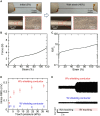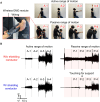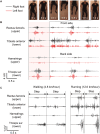A body-scale textile-based electromyogram monitoring system with coaxially shielded conductive yarns
- PMID: 41091868
- PMCID: PMC12525953
- DOI: 10.1126/sciadv.adx4518
A body-scale textile-based electromyogram monitoring system with coaxially shielded conductive yarns
Abstract
A crucial aim of wearable electronics is to acquire biological signals from the body with high precision. However, obtaining high-accuracy electromyogram (EMG) signals from a large area surrounded by noise sources remains challenging. In this study, we present a body-scale textile-based wireless electromyogram monitoring system with coaxially shielded conductive yarns that can reduce the influence of surrounding noise. The wiring yarns comprise three stretchable components: a conductive signal yarn, polyurethane insulating layer, and shielding conductor. The introduction of the shielding conductor suppresses noise contamination. The noise level remains below 0.1 millivolts, despite the wiring being directly pressed at nominal contact pressures exceeding 30 kilopascals. The muscle activity at various shoulder joint angles is successfully recorded when another person directly touches the arm and wiring for support. Furthermore, EMG monitoring of the lower body is performed during dynamic activities such as countermovement jumps, jogging, and running.
Figures




References
-
- Kim D., Lu N., Ma R., Kim Y., Kim R.-H., Wang S., Wu J., Won S. M., Tao H., Islam A., Yu K. J., Kim T., Chowdhury R., Ying M., Xu L., Li M., Chung H.-J., Keum H., McCormick M., Liu P., Zhang Y.-W., Omenetto F. G., Huang Y., Coleman T., Rogers J. A., Epidermal electronics. Science 333, 838–843 (2011). - PubMed
-
- Yamada T., Hayamizu Y., Yamamoto Y., Yomogida Y., Izadi-Najafabadi A., Futaba D. N., Hata K., A stretchable carbon nanotube strain sensor for human-motion detection. Nat. Nanotechnol. 6, 296–301 (2011). - PubMed
-
- Quer G., Radin J. M., Gadaleta M., Baca-Motes K., Ariniello L., Ramos E., Kheterpal V., Topol E. J., Steinhubl S. R., Wearable sensor data and self-reported symptoms for COVID-19 detection. Nat. Med. 27, 73–77 (2021). - PubMed
-
- Luo Y., Abidian M. R., Ahn J.-H., Akinwande D., Andrews A. M., Antonietti M., Bao Z., Berggren M., Berkey C. A., Bettinger C. J., Chen J., Chen P., Cheng W., Cheng X., Choi S.-J., Chortos A., Dagdeviren C., Dauskardt R. H., Di C., Dickey M. D., Duan X., Facchetti A., Fan Z., Fang Y., Feng J., Feng X., Gao H., Gao W., Gong X., Guo C. F., Guo X., Hartel M. C., He Z., Ho J. S., Hu Y., Huang Q., Huang Y., Huo F., Hussain M. M., Javey A., Jeong U., Jiang C., Jiang X., Kang J., Karnaushenko D., Khademhosseini A., Kim D.-H., Kim I.-D., Kireev D., Kong L., Lee C., Lee N.-E., Lee P. S., Lee T.-W., Li F., Li J., Liang C., Lim C. T., Lin Y., Lipomi D. J., Liu J., Liu K., Liu N., Liu R., Liu Y., Liu Y., Liu Z., Liu Z., Loh X. J., Lu N., Lv Z., Magdassi S., Malliaras G. G., Matsuhisa N., Nathan A., Niu S., Pan J., Pang C., Pei Q., Peng H., Qi D., Ren H., Rogers J. A., Rowe A., Schmidt O. G., Sekitani T., Seo D.-G., Shen G., Sheng X., Shi Q., Someya T., Song Y., Stavrinidou E., Su M., Sun X., Takei K., Tao X.-M., Tee B. C. K., Thean A. V.-Y., Trung T. Q., Wan C., Wang H., Wang J., Wang M., Wang S., Wang T., Wang Z. L., Weiss P. S., Wen H., Xu S., Xu T., Yan H., Yan X., Yang H., Yang L., Yang S., Yin L., Yu C., Yu G., Yu J., Yu S.-H., Yu X., Zamburg E., Zhang H., Zhang X., Zhang X., Zhang X., Zhang Y., Zhang Y., Zhao S., Zhao X., Zheng Y., Zheng Y.-Q., Zheng Z., Zhou T., Zhu B., Zhu M., Zhu R., Zhu Y., Zhu Y., Zou G., Chen X., Technology roadmap for flexible sensors. ACS Nano 17, 5211–5295 (2023). - PMC - PubMed
-
- De Luca C. J., Gilmore L. D., Kuznetsov M., Roy S. H., Filtering the surface EMG signal: Movement artifact and baseline noise contamination. J. Biomech. 43, 1573–1579 (2010). - PubMed
MeSH terms
LinkOut - more resources
Full Text Sources

